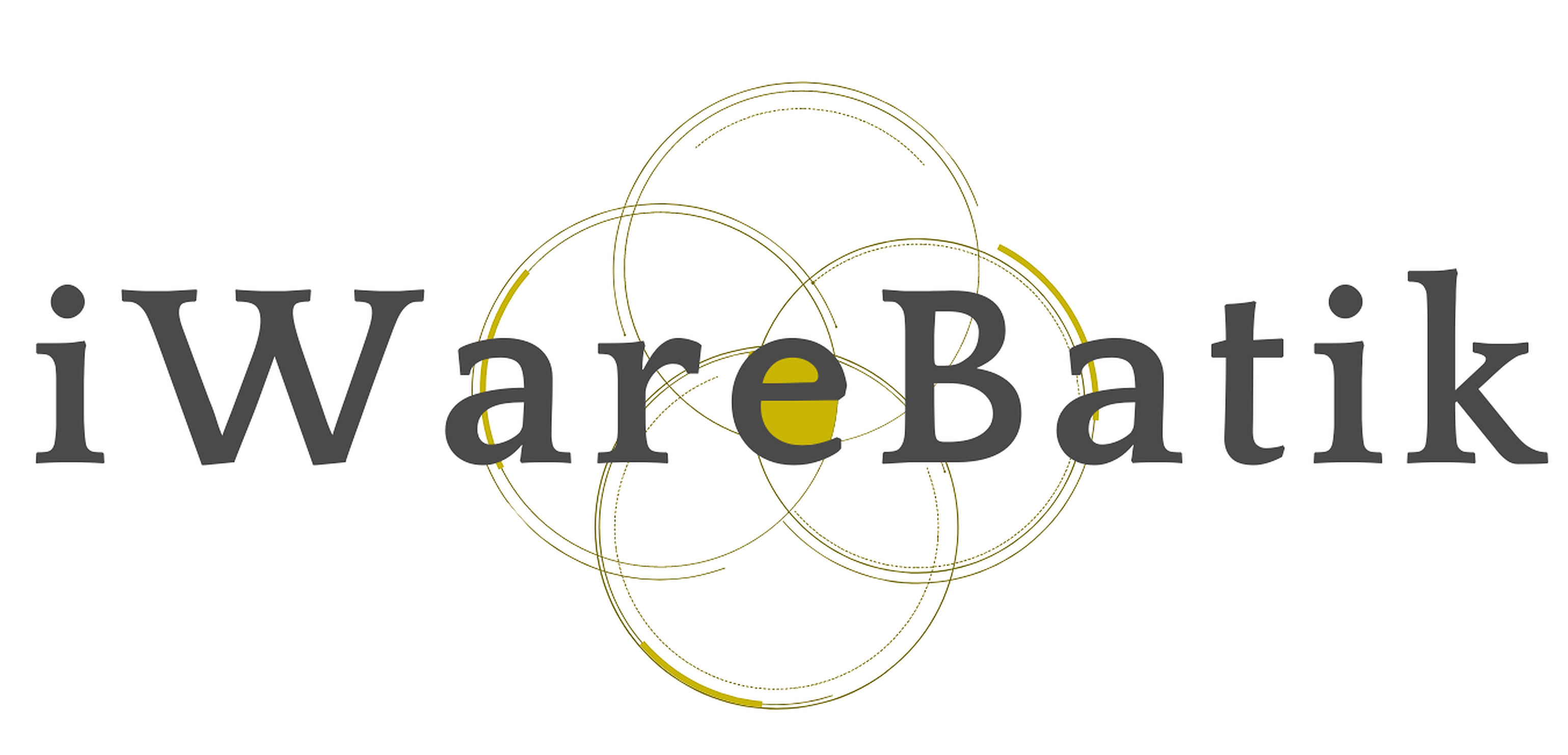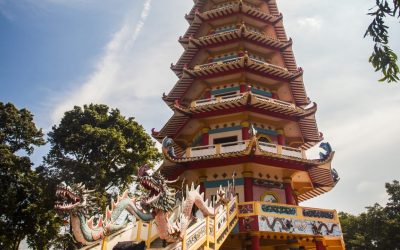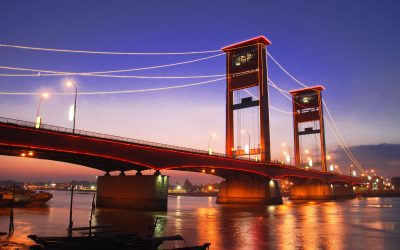Home / Batik Regions – Western Indonesia – Southern Sumatra – South Sumatra / Historical Grand Mosque of Palembang
Cultural Destination
Embrace the spirit of the place!
Historical Grand Mosque of Palembang
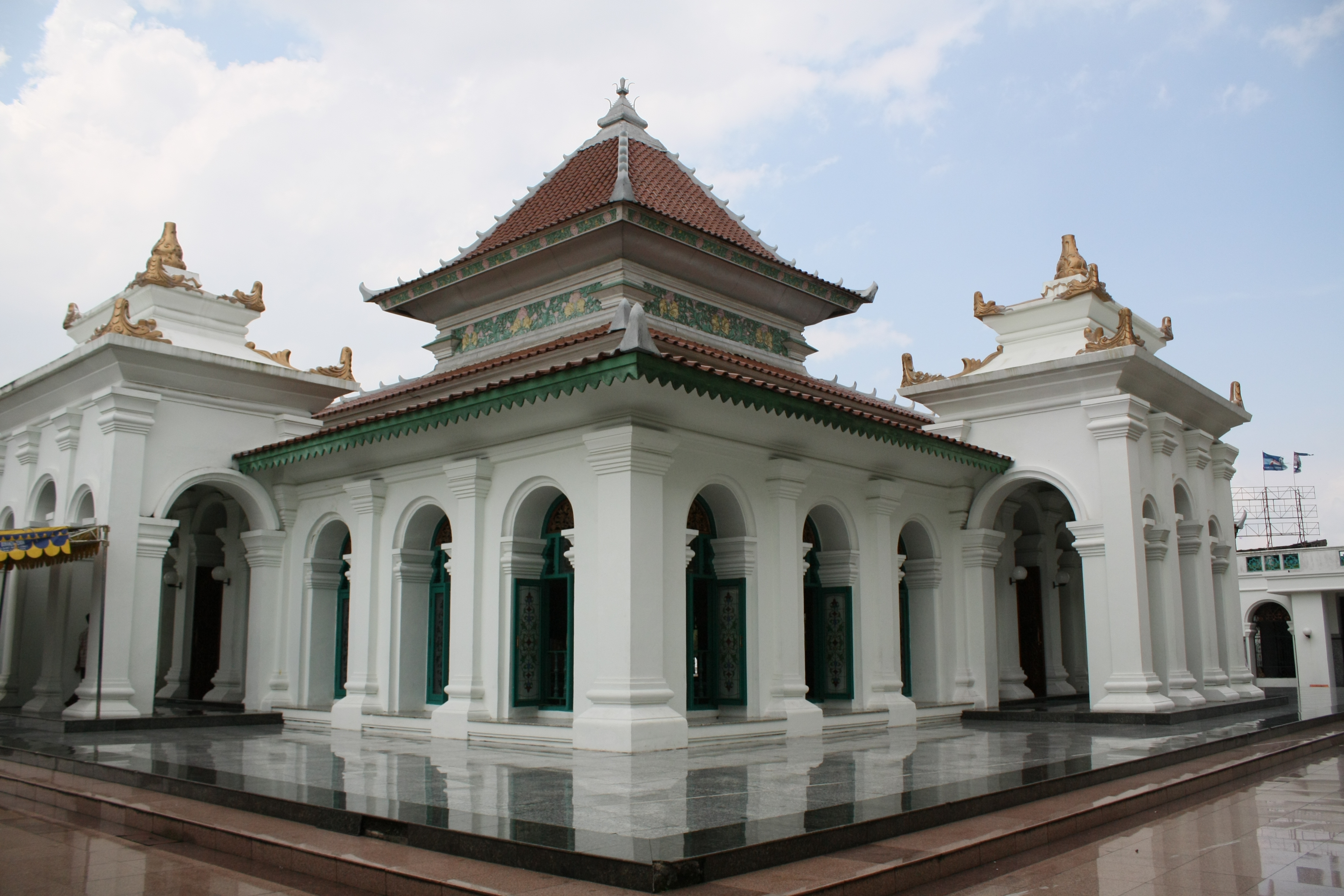
The Palembang Grand Mosque (photo: Fitri, wikipedia)
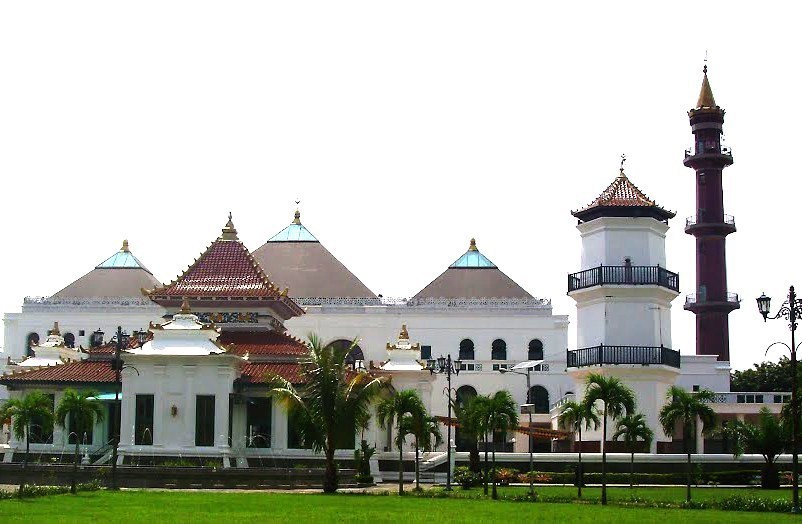
The front area of Palembang Grand Mosque (photo: Sumatranews)
Historical Grand Mosque of Palembang
The Grand Mosque of Palembang, founded in 1738, has a distinctive blend of three cultures, namely Indonesian, European and Chinese cultures. The three cultural characteristics are presented in every curve of the mosque building. The main door of the mosque, for example, shows the influence of European culture. The roof of the mosque is influenced by Chinese culture since it resembles the shape of a temple. The minarets show some characteristics that are closely related to the authentic Indonesian culture. The peak of the minarets are cone-shaped, which are called Tumpeng (a form of a mountain replica). They signify the connection between humans with their God, nature, and humanity.
Tourist Attractions in South Sumatra
Kemaro Buddhist Shrine
The island is famous for its legendary love stories like Romeo and Juliet,
Ampera Bridge
Ampera Bridge is a historic bridge which was built during 1962-1965 for
South Sumatra
Batik Motifs
Jupri Kembang Teh
Kembang Teh illustrates the tendrils of tea plants that grow in the highlands of
Bintik Tujuh
The Bintik Tujuh (Seven Dots) motif has 7 white spots and green color gradation as
Jumputan Bintang
The word Jumputan means the tie-dye technique, while the word “Bintang” refers to
Discover
Indonesian
Batik
Motifs
Hiu Taliyasan
Indonesia is also home to the world’s largest fish, the whale shark (Rhincodon typus). Hiu Taliyasan refers to
Gigi Haruan Lidi
The Gigi Haruan Lidi motif is taken from the name of the cork fish and is a symbol of
Wakatobi
It symbolizes the coastal beauty of the Wakatobi island and the symbol of Patra symbolizes
Karawo Mahkuta
Mahkuta refers to Gorontalo’s traditional crown. It represents noble characters of
Tenun Bima
The motifs are adopted from Bima woven textile. This pattern has received a great
Tikar Natuna
The Tikar Natuna motif is adapted from the traditional making of pandanus mats in
Tifa Totobuang
The batik motifs illustrate Maluku’s traditional music instrument called
Pattimura
Pattimura is the name of an Indonesian hero who fought against colonialism in
Durian Pecah
Broken Durian motifs depict the foundation of faith. The second half signifies the mastery of
Parang Rusak
Another meaning behind this motif is an unconquerable spirit, symbolized by
Kawung
The Kawung motif was created by Sultan Agung Hanyokrokusumo (1593 – 1645) as a symbolic gift for
Tubo Kelapa
Coconut tree is a symbol of a good character and strong mentality. It illustrates the more success a person, the more
Besurek Rafflesia
The term “Basurek” refers to a textile that contains letters or inscriptions
Ake Patra
Ake is related to the divinity and the composition of the universe. It is a symbol of
Pinawetengan
The Pinawetengan Batik pattern was taken from a prehistoric inscription in
Ukir Sentani
The Ukir motif is a batik motif that is inspired by various traditional Sentani wood carvings
Gamolan
This motif illustrates Gamolan, a bamboo musical instrument of Lampung that is
Tabir Tanjung
Tanjung flower is a type of Cherry tree flower, which is commonly found in
Gumin Tambun
Based on Hindu mythology, this motif symbolizes lucks, abundant wealth, and
Lok Baintan Floating Market
As you can imagine, the most authentic thing is that you can buy things and even
Kain Cual
Cual textile tradition has existed since the 17th century. The word “Cual” refers to
Burung Bidadari
Bidadari birds are endemic birds in Halmahera. This motif represents an
Awan Berarak
Awan Berarak is a combination of Dayak motifs and Malay patterns. The word ‘Awan Berarak’ means the
Kerawang Tegak Aceh
The Vertical Upright (Kerawang Tegak) Motif symbolizes a person who has a strong
Lontara
The Lontara script itself is a typical ancient script of Bugis and Makassar communities. History records that
Dayak Taghol
Dayak Taghol has a distinctive style of four curved lines and small dots. This motif represents
Salakanagara
Salakanagara batik motif illustrates the first kingdom in the Betawi land
Leuit Sijimat
This motif reflects the daily activities of the Baduy tribe in Banten. The main ornaments of batik motif consist of:
Paqbarre Allo
The word “Barre” means round and “Allo” means the sunlight. This motif is interpreted as
Malinau Cultural Festival
You will witness a unique competition that might not be found other than in
Bale Lumbu
This motif signifies the welfare of the ancient Sasak society. Bale also symbolizes the
Gonggong Beruntun
This motif illustrates that a person should maintain a positive attitude and
Rumah Mamuju
the Batik motif illustrates the house of Mamuju King with the stairs, located on the left of the wooden stage house
Kaharingan
The Kaharingan or ‘tree of life’ based on the Dayak tribes’ belief system. This tree symbolizes
Insang Ikan
Insang refers to the gills of the fish. This is a typical pattern of Malay ethnic who inhabits
Gedhog Kembang Waluh
a combination of Javanese cultural motif of the Majapahit kingdom (XII-XIV century) with
Pala Salawaku
This motif illustrates the unique weapons of the Maluku region, namely
Honai
The Honai is inspired by the traditional house of the Papuan community living in
Daun Sirih
This motif illustrates betel leaves that are used by Lombok communities as traditional
Gorga Simeol-Meol
The Gorga Simeol-meol is a pattern of plant tendrils. it is regarded as a symbol of longevity and
Tongkonan
Toraja’s traditional house is called Tongkonan. Tongkonan is a place for
Teguh Bersatu
This batik motif shows the strength of the people of Kupang. It also represents a sense of
Desa Na Tolu
The Desa Na Tolu characteristic pattern symbolizes the Batak philosophy of existence and
Parang Seling
Parang Seling or “alternating daggers” is a royal batik motif. It is a feminine variant of
Wirasat
Wirasat or divine inspiration is a gift from God. This inspiration is symbolized by
Bomba Mawar
This motif means sacred love for family, kingdom, and God; It also illustrates
Besurek Rembulan
This batik illustrates praise for God who created the wonderful universe
Bultiya
The word ‘Bultiya’ is an acronym of the three major tribes in North Kalimantan, namely
Gonggong Siput
Gonggong (Strombus Turturella) is one type of sea snail found around
Mahkota Siger
Siger is the crown of a noblewoman in ancient time. It is a symbol of femininity, strength, and
Enggang Dayak
Local people beliefs that hornbills are an incarnation of the Commander of the Birds. It has supernatural
Sido Mulyo
Sidomulyo is one of the classical motifs, which is specifically used for the bride’s costume in
Kaganga Tanah Rejang
If Batik Besurek combines Arabic calligraphy motifs, then the Kaganga batik takes
Prada Papua
The word “Prada” in the Javanese-Indonesian dialect means a batik textile that
Singayaksa
The Singayaksa motif comes from the name of a place where Sultan Hasanuddin used to
Angsa Duo
According to legend, the Angso duo batik motif is a pair of swans that are believed to have led Princess
Lipaq Sabe
Lipaq Saqbe contains a simple geometric classical motif with various flower decorations. This textile is
Jupri Kembang Teh
Kembang Teh illustrates the tendrils of tea plants that grow in the highlands of
Pucuk Rebung Riau
Pucuk Rebung symbolizes heart determination in achieving goals, good luck, and
Rangkiang
The word “Rangkiang” refers to the rice granary in the Minangkabau language. It symbolizes
Tampuk Manggis Sasirangan
The motif illustrates the philosophy of the mangosteen fruit, which is
Tengkawang Ampiek
With its many advantages, the Dayaks use this leaf in ritual ceremonies. This plant is a symbol of
Tanah Liek
The word “Tanah Liek” refers to clay in Minang language. It is also known as
Sekar Jati
Sekar means flower and Jati refers to teak trees that symbolizes a strong mental character that
Merak Ngeram
The hatching peacock motif has a very deep meaning which refers to the sacrifice and
Srimanganti
The name of the Srimanganti motif is derived from Palace’s hallway that connects to
Gurdo Solo
Gurdo or garuda bird is the mount of the Indian god Vishnu. As the Sun Bird,
Sandeq
Sandeq Boat is a symbol of the maritime importance of the West Sulawesi region. The greatness of
Daun Lada Hitam
The black pepper motif represents the main commodity of Bangka Belitung
Gajah Way Kambas
The motif illustrates the Lampung’s natural reserve, the Way Kambas. it also symbolizes
Jumputan Bintang
The word Jumputan means the tie-dye technique, while the word “Bintang” refers to
Karawo Pinang
Pinang refers to the Palm areca tree. This motif is considered as the original
Kasih Tak Sampai
‘Kasih Tak Sampai’ is an idiom in the Indonesian language which refers to
Kuda Kupang
Horses symbolize wealth. It contains noble values of virtuous characters that bring
